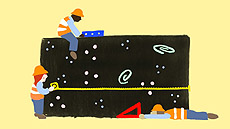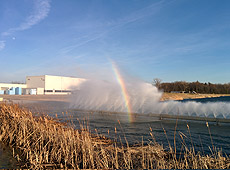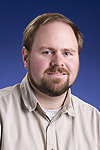|
|
Our flat universe
 |
| Our observable universe has not a curve in sight, as far as the eye can see. Image: Sandbox Studio
|
Mathematicians, scientists, philosophers and curious minds alike have guessed at the shape of our universe. There are three main options to choose from, in case you'd like to do some digging of your own:
The universe could be positively curved, like a sphere.
The universe could be negatively curved, like a saddle.
The universe could be flat, like a sheet of paper.
As far as scientists can tell, this third option is correct. But what do people really mean when they talk about "flatness"? Your high school math teacher would be overjoyed to tell you that it's all about geometry.
In a flat universe, Euclidean geometry applies at the very largest scales. This means parallel lines will never meet, and the internal angles of a triangle always add up to exactly 180 degrees — just like you're used to.
But in curved universes, whether finite or infinite, things get weird. In a positively curved universe, space bulges, skewing parallel lines toward a single point and inflating the sum of angles in a triangle to more than 180 degrees. In a negatively curved space, parallel lines diverge forever and triangle angles get pinched, so the sum is less than 180.
Read more
—Lauren Biron
|
Lab-Corps Pitch Competition at Argonne - April 17
The Lab-Corps Pitch Competition at Argonne National Laboratory is the final stage for participation in the prestigious Lab-Corps training program.
The competition takes place on Friday, April 17, from 2-4 p.m. at Argonne. Register for the event.
Fermilab staff are encouraged to attend and support their colleagues. While there, you can find out more about the wide range of technologies under development at Argonne. Everyone is welcome to attend this event, which is open to the public.
Six teams from Argonne will each make a five-minute pitch of their value proposition to a panel of four industry experts. Each pitch will be followed by a five-minute question-and-answer session. The panel will then make a decision, and the names of the winning teams will be announced. The winning teams will each receive $75,000 to be spent on Lab-Corps training and commercialization of their technology.
Lab-Corps is a new Department of Energy program that gives national laboratory staff the opportunity to determine if their technology is suitable for commercialization. The program is centered on iterating a business model canvas and customer discovery process.
If you have questions, please contact David McCallum, Lab-Corps program manager, or Jason Pariso, Lab-Corps training advisor.
|
Light refracts at Main Injector
 |
| Perhaps the hidden treasure has been in the Main Injector pond all along. Photo: Aleksandr Romanov, AD |
|
The top quark, 20 years after its discovery
From Physics Today, April 2015
Editor's note: The Top at Twenty workshop takes place at Fermilab this week, from April 9-10. Visit the workshop website for more details.
The heaviest of nature's elementary particles plays an outsized role in many fundamental processes. But because the top quark is so massive, it eluded experimental detection for nearly two decades.
Ever since the days of the Greek philosophers, humankind has sought to identify the elementary building blocks of matter. Over time, the notion has been refined; the original idea that indivisible atoms were the fundamental elements has evolved to the present view that objects called quarks lie at the heart of all matter. So in 1995 the discovery at Fermilab of the top quark — the sixth and possibly last of the quarks — might have been thought to signal the end of one of science's longest searches.
In 1964 Murray Gell-Mann and George Zweig independently proposed the quark hypothesis to account for the explosion of subatomic particles discovered in accelerator and cosmic-ray experiments during the 1950s and early 1960s. More than 100 new particles had been observed, most of them strongly interacting and very short-lived. Those strongly interacting particles, called hadrons, are not elementary; they possess a definite size and internal structure.
Read more
|
|
The new Target Systems Department at the Accelerator Division
 |
|
Bob Zwaska
|
Bob Zwaska, head of the newly formed Target Systems Department, wrote this column.
On Monday, Feb. 9, Chief Accelerator Officer Sergei Nagaitsev formally instituted the Target Systems Department within the Accelerator Division of Fermilab. The TSD will design, construct and operate high-intensity target
facilities and their associated systems and components for research with
intense particle beams at Fermilab. It will also conduct fundamental and applied research and development to build and maintain expertise in target-related technologies as a core competency for experiments and facilities making use of high-intensity, high-energy particle beams. The TSD workforce consists of technicians, engineers and physicists with experience and responsibility in high-intensity target facilities.
All present accelerator-based experiments at Fermilab use targets. The target converts the high-energy proton beam from the accelerator complex into new particles (generally through the strong interaction). The proton beams produced in the synchrotrons are not ends in themselves. Only when new particles are created from the protons does it become interesting for particle physics. Fixed-target experiments are very efficient ways of producing particles though high-energy interactions, consuming almost all of the proton beam.
High-intensity fixed-target facilities provide unique challenges. The beam components must be able to withstand sustained, high-power proton beams, which cause stresses, heating and eventually radiation damage and corrosion of materials. The target itself must sit directly in the beam, and generally it is advantageous to squeeze the beam to a small size, sharpening the stresses inflicted on the target. Furthermore, other devices such as magnets and instrumentation must reside near the target, suffering similar effects as the targets.
The Target Systems Department will integrate the phases and functions of high-intensity facilities. TSD will be the repository of knowledge for specialized devices such as targets, horns, lenses, windows, absorbers, collimators and shield piles. TSD's activities will span all of Fermilab's high-intensity facilities, currently NuMI and the Booster Neutrino Beamline, in the near future Muon g-2 and Mu2e, and eventually LBNF/DUNE and other future experiments. TSD's involvement in these devices and facilities will start with R&D, continue through design, construction and operation, and eventually conclude with remote handling and disposal.
Future facilities at Fermilab, particularly those based on PIP-II and other future accelerators, will be possible only with advances in the technologies and materials of targets and other devices within the target facility. Just in the last few weeks the accelerators started producing record intensity beam powers for NuMI, and we expect to reach 700 kilowatts over the next year or so. The High-Power Targetry program within TSD will address these challenges through focused research and development. This program was recently highlighted as the number one recommendation of the HEPAP Accelerator R&D panel. A major component of this program is the RaDIATE collaboration to examine materials, which will be the subject of a future column by Patrick Hurh.
The establishment of a Target Systems Department orients the Accelerator Division toward Fermilab's current portfolio of experiments, and those for the foreseeable future. The issues regarding targets will only become greater as time goes on and beam powers increase. TSD will maintain and propel Fermilab's expertise needed for future experiments.
|
ESH&Q weekly report, April 7
This week's safety report, compiled by the Fermilab ESH&Q Section, contains one incident.
An employee missed the bottom step while descending a step ladder. He fell, striking a desk chair on the way down, and fractured a rib. This is a DART case and will be entered into the DOE Occurrence Reporting and Processing System.
See the full report.
|
Creation's Birthday @ Genesis Theatricals
From Chicago Stage Standard, March 26, 2015
Editor's note: "Creation's Birthday," a play by Fermilab Chief Technical Officer Hasan Padamsee, is showing at the Athenaeum Theatre in Chicago through April 19. Fermilab employees are eligible for a discount.
Walking into the small theatre, the first thing I saw was a chalk board, physics equations scribbled here and there. Chairs lined in front of it. In right center stage a table for three, and a small desk with water and wine to left center. The first thing I heard was Joplin playing; "Is this 'Easy Winners'?" I was in early 20th century America, 1918, at a conference at Northwestern University. Edwin Hubble, our story's main man, is just getting on his feet as an astronomer, and is invited to the largest U.S. telescope at the time, in California. Hubble eventually takes the job, and the scientific journey begins. The plays centers on Hubble, not Einstein, and his journey as a young scientist to one of prominence.
Read more
|
|